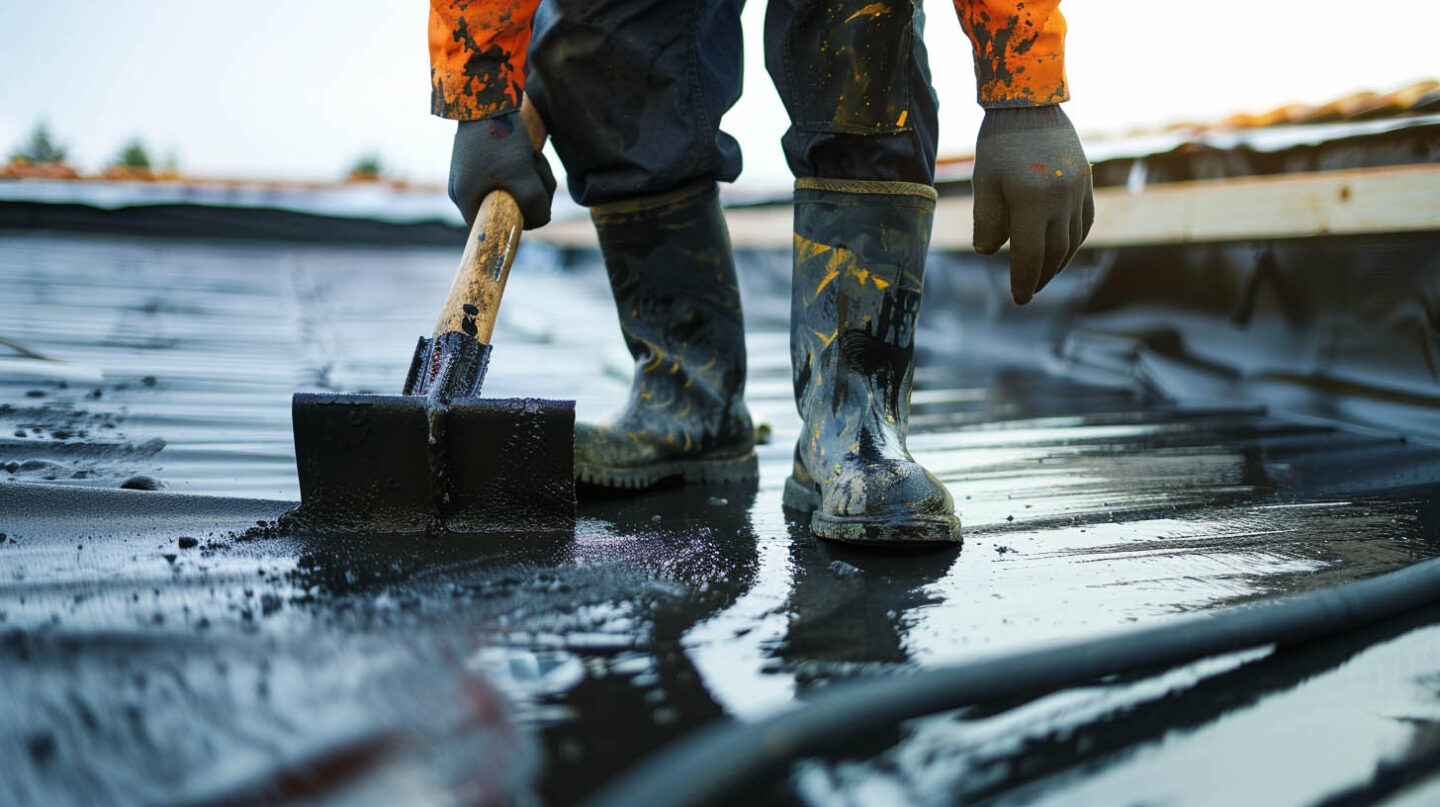When you invest in a new roof with The Shingle Master, you’re protecting your home and your family. But have you ever thought about the hidden ingredients in roofing materials? Many traditional roofing adhesives and primers contain Volatile Organic Compounds (VOCs), chemicals that can be released into the air. At The Shingle Master, we believe in “Protecting Wha Matters,” which includes your health and the environment in Durham, NC. This guide will explore the benefits of choosing safer, low-VOC roofing products, offered by our expert team, for a healthier, more sustainable home.
Understanding VOCs in Roofing Products
The term “VOCs” might sound technical, but its impact is straightforward. These compounds are present in many building materials, including those used in your roofing system. They are often found in the solvents that make products like adhesives and primers easy to apply.
As these materials cure, VOCs are released, which can affect air quality. Understanding where these compounds come from is the first step in making an informed choice about the products used to secure your roof membranes. We’ll look closer at what VOCs are and their common sources.
What Are Volatile Organic Compounds (VOCs) in Roofing?
Volatile Organic Compounds (VOCs) in roofing are chemicals emitted from various building materials, including adhesives and primers. They can adversely affect indoor air quality and contribute to environmental pollution. Understanding their presence helps homeowners make informed choices for safer and more sustainable roofing solutions.

Common Sources of VOCs in Adhesives & Primers
Numerous components commonly found in adhesives and primers contribute to the presence of volatile organic compounds (VOCs). Solvent-based formulations, often used in roofing applications, release VOCs as they cure, affecting indoor air quality. Additionally, polyurethane foam adhesives and certain sealants can contain significant VOC content. Analyzing safety data sheets can reveal the specific compounds present, helping consumers make informed choices. By selecting low-VOC alternatives, homeowners and contractors can enhance the sustainability of their roofing system while minimizing harmful emissions.
Health & Environmental Benefits of Low-VOC Roofing Solutions
Opting for low-VOC roofing solutions is a choice that benefits both your home’s immediate environment and the planet. By minimizing the release of harmful chemicals, you create a healthier living space. This decision also reduces your project’s overall environmental impact, contributing to cleaner air.
Verifying the materials used in your roofing system is simple; a professional contractor can provide Safety Data Sheets (SDS) that detail a product’s chemical makeup and VOC content. Let’s explore how these choices protect your home and the environment.
Reducing Indoor Air Pollution for Safer Homes
Indoor air quality significantly improves with the use of low-VOC roofing products, as these materials release fewer harmful emissions. By opting for adhesives and primers with lower VOC content, homeowners can mitigate the risks associated with volatile organic compounds, which contribute to respiratory issues and chronic health problems. Additionally, ensuring proper ventilation during application enhances safety further. The use of sustainable materials in roofing systems not only fosters healthier living environments but also promotes long-term durability and performance of roof membranes.

Minimizing Environmental Impact Through Material Choice
Making conscious material choices is crucial for reducing the environmental footprint of roofing projects. Opting for low-VOC adhesives and primers often means selecting products that are safer for both the installer and the surrounding community. Utilizing advanced formulations that prioritize sustainability not only enhances the durability and adhesion of roof membranes, but also significantly cuts down on harmful emissions. Materials like polyurethane foam and eco-friendly coatings ensure compatibility with various substrates, paving the way for greener roofing solutions.
Low-VOC Adhesives: How They Compare to Traditional Options
When you decide to use low-VOC roofing adhesives, it’s helpful to understand how they differ from traditional options. While both are designed to create a strong bond, their chemical makeup leads to different performance characteristics and application requirements. Safer options, like water-based or advanced polyurethane foam adhesives, offer excellent adhesion and durability.
The key is knowing what to expect. At The Shingle Master, we have the expertise to work with these modern materials, ensuring a secure and long-lasting result. Next, we’ll examine the specific performance and application differences.
Performance Differences Between Low-VOC and Standard Adhesives
Differences in performance between low-VOC and standard adhesives can significantly affect a roofing project’s success. Low-VOC options often provide comparable adhesion qualities while being more environmentally friendly. Their formulation typically enhances durability against moisture and UV exposure, making them suitable for various substrates like EPDM, TPO, and metal roofing. Additionally, low-VOC adhesives often come with excellent safety data sheets, ensuring users are well-informed about their properties. These advantages lead to better long-term sustainability for roofing systems.

Application Methods: What Homeowners & Contractors Should Know
Choosing the right application method is crucial for maximizing the effectiveness of low-VOC adhesives and primers. Homeowners and contractors alike should familiarize themselves with specific requirements for each roofing system, such as TPO and EPDM membranes. Ensuring appropriate substrate preparation—like plywood or bitumen—enhances adhesion and durability. Additionally, adhering to safety data sheets during application not only minimizes air pollution but also aligns with sustainability goals. Understanding these methods aids in achieving optimal performance while mitigating VOC emissions.
Selecting the Right Low-VOC Primer for Your Roof
Just as important as the adhesive is the primer that prepares the surface for bonding. A primer ensures that the adhesive creates the strongest possible connection between the roofing material and the substrate. When going the low-VOC route, it’s essential to select a primer that is not only low in emissions but also fully compatible with your chosen roofing system.
The right low-VOC primer will promote superior adhesion for various roof membranes, from single-ply to asphalt systems. Let’s look at which primers work best with different materials.
Suitability for EPDM, TPO, PVC, and Asphalt Roofing Systems
Each roofing system, whether it’s EPDM, TPO, PVC, or asphalt, has unique characteristics influencing adhesive compatibility. Low-VOC adhesives excel in bonding these materials, offering exceptional adhesion while minimizing harmful emissions. For EPDM and TPO, consider solvent-free options that provide robust performance without compromising health standards. PVC benefits from adhesives designed for high UV stability, while asphalt systems thrive with polyurethane foam adhesive for reliable moisture resistance. Prioritizing low VOC options aligns with sustainability goals while enhancing durability across these roofing solutions.

Factors to Consider When Switching to Low-VOC Primers
Transitioning to low-VOC primers involves several critical factors. Analyzing the specific roofing system—whether it be EPDM, TPO, PVC, or asphalt—ensures compatibility and optimal adhesion. Evaluating the moisture resistance and durability of low-VOC options is essential, as these can impact the long-term performance of roofing membranes. Additionally, reviewing the safety data sheets for any adhesives used alongside the primer can help identify potential hazards and ensure full compliance with safety regulations. Always consider warranties and manufacturer recommendations during this process.
Get in Touch
Choosing low-VOC roofing solutions not only promotes a safer living environment but also contributes positively to sustainability efforts. By selecting adhesive products and primers with reduced VOC content, homeowners can enhance the durability and performance of their roofing systems while ensuring compliance with safety data sheets. Investing in these innovative materials leads to improved indoor air quality and mitigates environmental impact, making the transition to low-VOC options a wise choice for anyone looking to protect both health and habitat. As a GAF Master Elite Contractor, BBB A+, Haag Certified Inspector, NC Licensed General Contractor, and recognized as Raleigh’s Best Roofing Contractor by NHBA and the Raleigh Chamber of Commerce, we are committed to delivering quality and safety in every project.
Frequently Asked Questions
What is the least toxic construction adhesive?
The least toxic construction adhesives are typically those with zero or very low VOC content. This includes water-based formulas and 100% solids adhesives like advanced polyurethane foam products. These options cure without releasing the harmful solvent fumes associated with traditional adhesives, making them a much safer choice.
What is considered low-VOC adhesive?
Low-VOC adhesives are those with reduced levels of volatile organic compounds, typically containing less than 180 grams per liter. They are designed to minimize harmful emissions during application and curing, making them safer for indoor environments while maintaining effective bonding strength for roofing materials.
What glue has no VOC?
Adhesives labeled as “zero-VOC” or “100% solids” contain no solvents that evaporate during curing. These advanced adhesives, which can include polyether or polyurethane foam formulas, are designed to bond materials like TPO and EPDM membranes securely without releasing any harmful VOCs into the atmosphere.
Read our blog: Ice Dams in the Triangle? Rare—Here’s When They Happen


